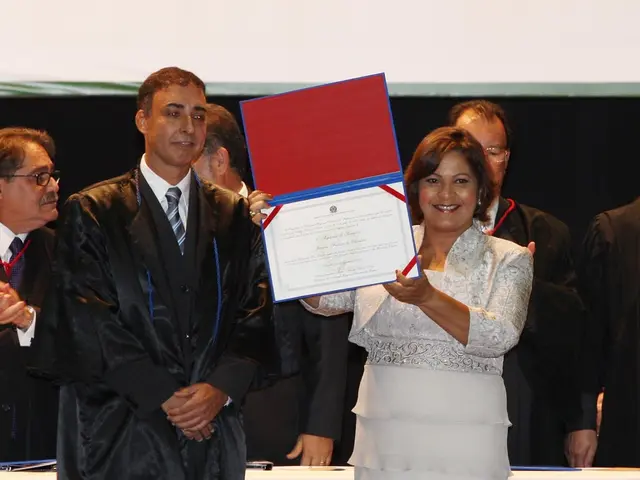Characteristics of U.S. Congress Members and Election Procedures Unveiled
The United States' legislative branch, the Congress—composed of the House of Representatives and the Senate—plays a crucial role in shaping America's laws and policies. To decipher the heart of our nation's government, it's essential to grasp the traits of its representatives and the process of their elections.
Who Runs the Show?
- Diverse Pasts: Ranging from legal eagles to science whizzes, Congress members come from a broad spectrum of backgrounds. Still, you'll spot a heavy presence of those with political or business backgrounds.
- A Changing Tide: As the face of America grows more diverse, the Congress reflects this evolution, witnessing a spike in the number of women, people of color, and younger members.
- Smart Cookies: The majority of representatives are well-educated, with many totin' law degrees to match the legislative nature of their roles.
- Leaders, Communicators, and Negotiators: Strong leadership, sharp communication skills, and the ability to bridge differences are hallmarks of successful Congress members. They need a keen sense of their constituents’ needs.
- Standing for Your Hood: At the core of Congressmembers' responsibilities is advocating for their constituents' interests and concerns.
The Election Gameplan
- 21st Century Founding Fathers and Mothers: To be elected to the House, aspirants must be at least 25, seven-year U.S. citizens, and local residents. The Senate requirements are a touch stricter: a minimum age of 30, nine years as citizens, and a residency in the state.
- Battleground Time: House members serve two-year terms; every two years, the entire House is on the ballot. Senators have it easier with six-year terms, with approximately one-third of the Senate seats up for grabs every two years.
- Primary Party Time: Before the main event, most states host primary elections in which parties decide their candidates. Primary types differ by state, but the essential spirit remains the same.
- Hustlin' for Votes: Campaigning for Congress is no walk in the park. It's a high-octane mix of fundraising, advertising, public speaking, and connectin' with constituents.
- The Final Battle: The general election unfolds on the first Tuesday after the first Monday in November. The candidate who snags the most votes wins the day.
- Political Machines at Work: Political parties are crucial players in the election process, supplying resources, endorsements, and voter mobilization.
- Redrawing the Map: Redistricting, or redrawing district boundaries every ten years based on census data, can impact electoral outcomes, particularly when gerrymandering enters the equation.
- Money, Money, Money: Campaign finance is regulated, with contribution caps and reporting requirements. But the influence of PACs, Super PACs, and lobbyists continues to grow, leading to debates about the power of cash in politics.
- Get Out the Vote: Voter turnout fluctuates, with higher numbers often seen in presidential election years. Efforts to boost participation include registration drives, early voting, and mail-in ballots.
- To the Oval Office!: After the elections, successful candidates take the oath of office in January, ready to strut their stuff in Congress.
Committees: The Heartbeat of Congress
- Power Players: Committees are the lifeblood of the legislative process, handling the intricate work of scrutinizing, editing, and debating proposed legislation.
- Specialized Squads: There are several types of committees, like standing (permanent) committees, select committees (created for special purposes), and joint committees (including members from both houses).
- Choosin' Your Team: Members strive to secure assignments on committees related to their interests or their constituents'. Seniority, expertise, and party loyalty often determine these appointments.
How a Bill Becomes a Law
- Draft Day: The legislative odyssey starts when a member proposes a bill. This piece of legislation is then handed off to a relevant committee for analysis, hearings, tweakin', and approval.
- The Debate: If a bill escapes the committee, it hits the floor of either house for discourse, amendment, and a vote. The House's rules are more structure-y, whereas the Senate allows rent-free banter.
- Bi-Cameral Harmony: For a piece of legislation to become law, both the House and Senate must pass identical versions. If they differ, a conference committee might be summoned to hash out the differences.
- The President's Big Decision: Once Congress makes its move, the bill goes before the President. The President can sign it into law, veto it, or claim executive privilege (pocket veto).
Watchdoggin' the Executive Branch
- Oversee and Review: The power to scrutinize the executive branch is a major part of the Congress's job, ensuring laws are enacted as intended and keeping tabs on executive power.
- Investigations and Hearings: Committees are in the driver's seat for this oversight, with the help of investigations, hearings, and reports.
Lobbyists and Interest Groups: The Uninvited Guests at the Policy Party
- Influencing Decisions: Lobbyists and interest groups actively attempt to sway Congressional decisions, offering information, knowledge, and occasionally campaign support in exchange for legislative advantage.
- Transparency Measures: The Lobbying Disclosure Act and other regulations require lobbyists to register and report their activities, aimin' to foster openness in this influential process.
Addressin' Electoral Challenges and Reforms
- Incumbency Advantage: Incumbents often enjoy an upper hand in elections, thanks to name recognition, fundraising prowess, and established political networks.
- Reform Proposals: Varying electoral reform ideas have surfaced to tackle perceived problems in the Congressional election process, such as campaign finance reform, term limits, and anti-gerrymandering measures.
Wrapping Up
The United States Congress is a lively and complex machine, a reflection of the diverse concerns and histories of the American populace. From the intricacies of individual members' backgrounds to the dynamics of the election process, a thorough comprehension of Congress adds depth to our understanding of the broader American political and civic landscape. So, buckle up, because understanding the Congress is like learning the secret lyrics of our nation's political anthem!
- The executive branch, a fundamental part of the American government, is subject to oversight by the Congress to ensure laws are enacted as intended and to keep tabs on executive power.
- The Congress, a key component of political science, plays a vital role in shaping America's laws, policies, and overall political landscape, mirroring the diverse backgrounds and evolving demographics of the nation.
- A successful Congress member is characterized by strong leadership, sharp communication skills, and the ability to bridge differences, while prioritizing the needs of their constituents.
- The legislative process within the Congress involves committees, which are pivotal in scrutinizing, editing, and debating proposed legislation, as well as reviewing the executive branch.
- The political news cycle is deeply intertwined with the activities of the Congress, with general news outlets covering everything from elections to policy and legislation, making education and self-development in political science essential for informed citizenship.
- The process of electing Congress members involves various steps, including primary elections, campaigning, and general elections, with key differences between the House of Representatives and the Senate.
- Campaign finance, redistricting, and voter turnout are critical aspects of the election process, with debates swirling around the influence of money, the impact of redistricting, and efforts to boost voter participation.
- Lobbyists and interest groups play a significant role in influencing Congressional decisions, often offering support in exchange for legislative advantage. Transparency measures, like the Lobbying Disclosure Act, aim to ensure openness in this process.
- Electoral challenges and reforms are continually addressed, with proposals encompassing campaign finance reform, term limits, and anti-gerrymandering measures aimed at fostering a fair and democratic election process.
- Learning about the United States Congress offers valuable insights into the nation's political and civic framework, making it akin to discovering the secret lyrics of the political narrative that shapes our country.








